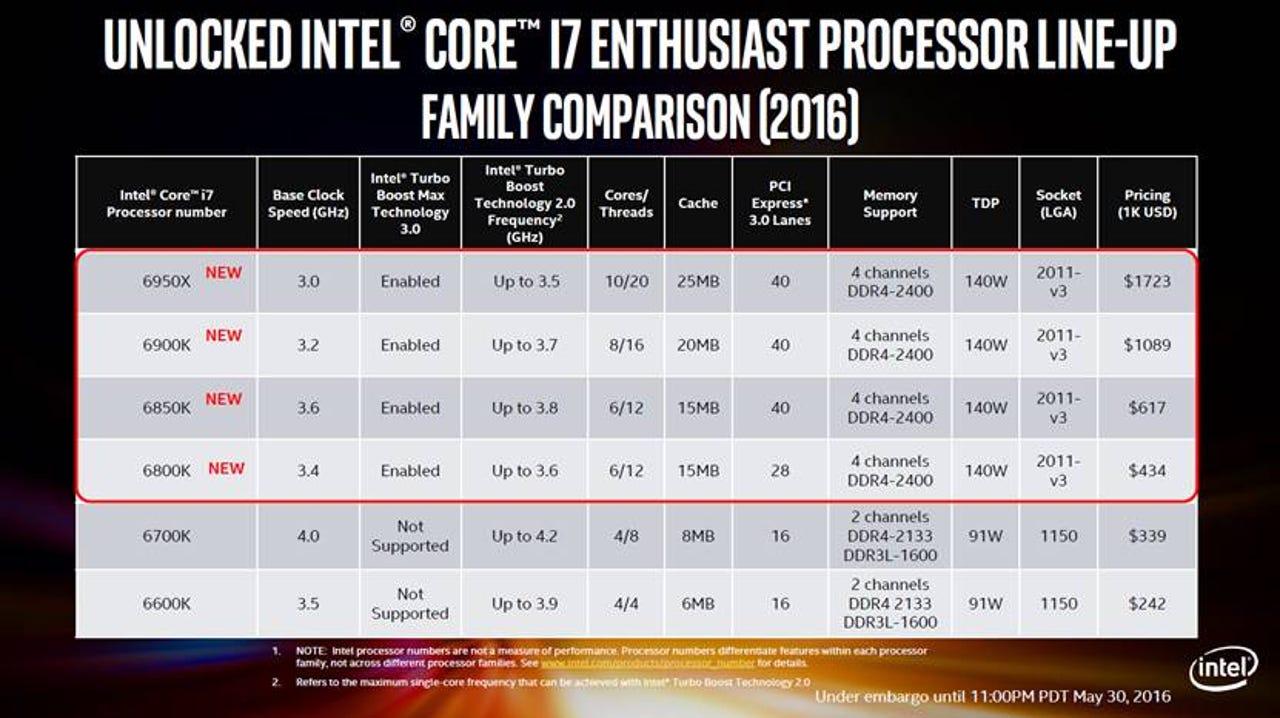Intel goes Broadwell for 10-core 'monster' i7 Extreme Edition CPU

Intel has introduced its first 10-core desktop processor in the form of the Core i7 6950X, which, thanks to hyper-threading, allows for 20 logical cores to be presented to the operating system.
The 6950X is the beefiest of a new quartet of Broadwell-E processors released by the chip giant -- with the 8-core i7 6900K and 6-core i7 6850K and i7 6800K also available -- and arrives with 25MB of cache, a 3GHz base clock speed, support for 4-channel DDR4-2400 memory, 40 PCI-E lanes, and a $1,723 price tag.

Compared to its brethren, the 6950X has the lowest base clock frequency, and as cores are reduced across the family, the base and turbo frequencies available increase.
"As we start increasing cores, we start decreasing frequency in each of the SKUs. And the reason we do that is because when you increase cores, you're increasing the power consumption and the thermal density in the package, and something has to give to fit within that package and the thermal envelope," Frank Soqui, Intel general manager for Enthusiast Desktop Products, said.
Soqui highlighted that the Broadwell-E chips arrive with the third-generation Turbo Boost Max feature, which the company claims is 15 percent faster than previous generations.
"This is frequency improvements even over Turbo Boost 2.0, and we do that without having to break the warranty," he said.
"This is not overclocking, this is a sustained higher frequency than what you get with Turbo Boost 2.0, because we can characterise individual CPUs and get the highest frequency possible out of those 10 cores."
Based on Xeon processors, the new extreme chips are based on the Broadwell architecture rather than the newer Skylake architecture. Intel told ZDNet that the cadence difference between the mainstream Skylake processors and the Broadwell-E Extreme Edition processors was primarily driven by Xeon timing.
Hiral Gheewala of Intel's Platform Evaluation team conceded that the choice of Broadwell has some drawbacks, however.
Featured
"When you compare a Skylake to a Broadwell, we are losing some performance in terms of instructions per clock, because now you are comparing a sixth-generation Skylake product to a fifth-generation Broadwell," he said. "And also, the Skylake product has a higher Turbo frequency than the Broadwell product that we are talking about."
The new Broadwell-E chips are built using 14nm Tri-Gate 3D transistors, arrive fully unlocked without a cooler, and are available today. The chips need a motherboard with a LGA2011-v3 socket and X99 chipset, and a BIOS update is needed for existing motherboards to be able to use Turbo Boost Max 3.0.
Intel touts benchmark improvements such as 25 percent improvements on video editing, and 35 percent improved 3D rendering performance over the prior generation of Extreme chips. However, the systems they were tested on were quite different with the 6950X processor having access to 8x 8GB of DDR4-2133MHz memory, and the 5960X and 6700K chips it was compared against only being able to address 4x 4GB of DDR4-2133MHz RAM.
"We used the configurations we believe systems shipped with when we launched the parts," Intel told ZDNet in response to why the configurations were so different. "Essentially keeping the installed base as it was two years ago compared to what we expect the Broadwell-E systems would be today.
"For testing purposes, people can swap out memory as they see fit to do their testing, but that's why the systems were configured as they were."
The chip giant introduced a new Xeon processor, the Broadwell-based Xeon E5-2600 v4, in April.
Forgoing its previous desktop focus, the company has said recently that it is targeting the cloud and the Internet of Things (IoT).
"Our strategy itself is about transforming Intel from a PC company to a company that powers the cloud and billions of smart, connected computing devices," Intel CEO Brian Krzanich said.
"We see tremendous opportunity in the growth of this virtuous cycle -- the cloud and datacentre, the Internet of Things, memory, and FPGAs all bound together by connectivity and enhanced by the economics of Moore's Law."
As part of its shift, Intel cut 11 percent of its workforce, representing 12,000 jobs.
"The majority of these actions will be communicated over the next 60 days, with some spanning into 2017," Krzanich said in April.
Intel earned $2 billion on revenue of $13.7 billion for its first quarter of the year.